What a rush!
As part of our (mine and Christian Crumlish) presentation at Idea 09, we were presenting from our book: Designing Social Interfaces – 5 Steps, 5 principles and 5 anti-patterns. The talk went well but the big deal was unveiling and playing the game.
While we were writing the book, we had discussed doing a set of Pattern cards. Like flash cards. Or the IDEO cards. Pretty cool idea and the patterns are perfect for cards. So I started to develop them and create the production files for them.
As I was designing the cards, I thought how much more interesting these would be if they were more interactive; like a game. So I started to research game design. In my travels I came across a most interesting PhD thesis in which the author had designed a game to teach game design. Called GameGame, this information was exceptionally helpful in fleshing out the design of the game – the material forced me to think about outcomes, about goals, about the end state, about points collecting and competition – in addition to what I hoped people would learn from a game where they build a social product. Additionally, I read everything I could find from Amy Jo Kim and her game mechanics papers and presentations.
I started by making a list of notes of ideas, things like:
- Games tap into primal response patterns
- Games engage us in flow
- Game mechanics in social
- Collecting – bragging rights, completion
- Points – game points by systems, social points by others, drive loyalty, drive behavior (Leaderboard), punctuate game experience by unlocking new powers or access
- Feedback – social feedback drives engagement, accelerates mastery and adds fun
- Exchanges – structured social interactions – explicit or emergent/implicit
- Customization – character or interface
I asked a lot of questions:
- How do you earn points?
- How do you get feedback?
- Where do you have exchanges?
- What do you collect?
Once we had finished the book draft we knew we had very large list of potential elements to work with. These included:
- 96 patterns
- 43 principles and practices
- 5 anti-patterns, 6 if you count Leaderboard
The other elements that needed to be accounted for in a product included:
- context – how is it delivered
- social objects – or need
- demographic – who is it for?
- anti-social behaviors – how do these come into play?
- rewards – things like early adopter and good press cards – how can I use these?
Then I started to flesh out some of the process of gameplay – ending up with a lot more questions.
- draw an object card
- draw some combination of pattern /principle card
- can a player discard and redraw?
- collaborate with others?
- combine cards?
- trade cards?
- trade with other teams?
- how do the anti-social behaviors come into play?
- what about the good things – moderation, good press.
- what is the end state – is there an end state or goal set of cards too?
- Do teams trade with other teams to get the cards needed to complete a product?
I then took these questions and an excel spreadsheet of the patterns, principle, antipatterns and other elements to my good friend Matt Leacock to get his help in wrangling these ideas into something playable. Matt is an award winning game designer and interaction designer. We brainstormed and sketched some end states. He took everything away and came up with a set of draft rules for the game.
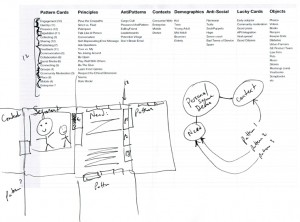

While he was drafting rules, I sketched out some more diagrams of what an end state might look like – from the pencil sketch we did at lunch. Looks pretty complicated but isn’t far off from where we have eventually ended up.
Once we had a draft set of rules, I had to finish the production of a draft set of cards.
I started out with the cards at 6×4 – thinking flash cards. But then I started to look into the prices for printing and soon realized that this size, for the quantity of different cards we potentially had, was totally unaffordable. So I started to look into trading card size – 3.5 x 2.5. A lot more options for printing – most still too expensive but a few on demand options that seemed relatively reasonable.
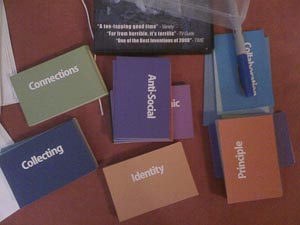
Taking the card sizes down, meant an edit on the content for every card. So while Christian and I were editing and proofing the manuscript for the book with our editors, I was cutting and pasting text into Illustrator and in some cases re-writing the patterns, principles and anti-patterns to fit the small size. I had already decided to cut the content down to the simplest form: What and When for the patterns. Figuring people will have to buy the book to get the how and all the examples.
I printed a set of cards on my large format printer (app. 25 up on 17×22 sheets) and hand cut the set out. I was able to print front and back so made a draft – Alpha – set of cards.
Meanwhile, Christian took a PDF of all the cards and printed the text sides and then took them to Overlap to have folks think about imagery and potential clustering for a poster idea we have.
We then took the draft rules, the Alpha set of cards, a couple of volunteers – thanks Brynn and Brendan – and we play tested the game. We discussed a lot of the mechanics as we played and the biggest thing that stood out was that there were too many cards. It was impossible to get the cards needed to create a product in the giant deck. We discussed breaking it into 4 sets of cards. We also discussed how the cards could go together.
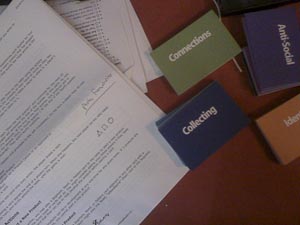
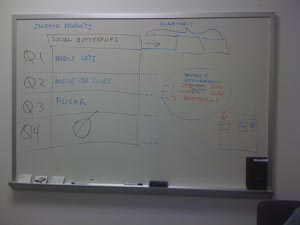
When Matt and I had been discussing the game, we talked about symbols along the edge of the cards to match up to symbols on the feature cards. I wasn’t sure how that could physically work given the size of the cards and the sheer number of categories. When we played the game though, it was clear there needed to be some mappings and the triangle, circle, square mappings emerged.
While the game was definitely designed for multiple teams to play, we were able to play it with 4 people. Once we finished, I came home and went through the notes. I amended the game rules to account for the issues we saw and added elements where we thought things were needed.
I went through the set of cards and did a cull to remove redundant or similar type patterns, and ended up removing over 50 cards.
Over the next couple of weeks I thought about the game play as I finished doing the card production. I sent the cards off to be printed – 4 up on 5×7 (cheap overnight prints for 5×7 cards) and a week later 4 giant boxes showed up on my doorstep. Next I had to have the cards cut, so I had that done locally. In the meantime, I had found a nice, gusseted clear plastic, string bound envelope to package the game in and ordered some stickers to put on the outside to brand it.
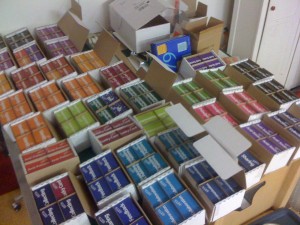
Once the cards were here, I had to collate and as I was thinking about that, I realized that 4 decks was going to be insane to play with so I ended up collating into 2 decks, interspersing the lucky cards and anti cards into each deck. The large deck features all the patterns (or features) and the smaller deck is the product particulars (who is it for, how will it be delivered and what is it about) or rather the social object, the delivery, and the demographic.
Starting over labor day and working on a few sets every night, then finally getting some help, I was able to put together 45 sets for IDEA 09.
At IDEA09 we played the game with two teams to see how it would go. It was great fun and I took a ton of notes from both watching what was working and from the questions and feedback from the players. The feedback helped craft a revised brief – quickplay – set of rules that we shared with folks at the conference the next day and gave me ideas for what needed to be clearer from a design standpoint on the cards.
So at the end of our presentation [great post from MaRS blog on our talk][recap of day 2 of IDEA on Johnny Holland], we set loose the people and the decks of cards. Note to self: explain the rules and the goals to people before setting them loose. We had promised Russ (the conference organizer) chaos, and boy did we deliver. It took an extra 15 minutes or so to explain the rules and goals of the game than it should have because once people got the game cards and were in their groups, they started talking and looking at the written rules rather than listening to me or looking at the Quick Play rules that I had up on the projector. Thank goodness we had several people from the night before interspersed on team, as they were able to help explain how to play.
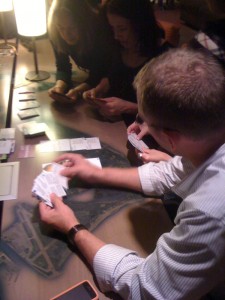
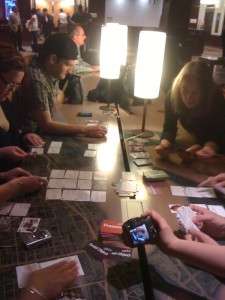
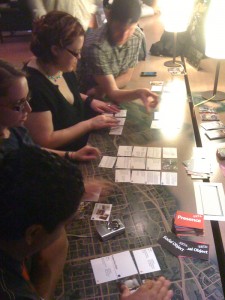
Once things got going it was pretty amazing to watch. Several teams were totally out for points and not really caring about product quality, until we reminded them that quality, a well balanced product tapping into the three main categories of Self, Activities and Community, would rack up extra points. Some teams were very thoughtful, discussing every feature as it would apply to their object or demographic. It was amazing to watch and see it actually working despite the chaos.
We discovered the night before that there were not enough delivery cards to map to the object cards, so people were allowed to wing it with post it notes or to reuse the cards once they shipped a product. Once we explained that negative cards could be played on someone else’s product it got really interesting and teams against teams really started to emerge.
It was fascinating to watch and take notes and just see what was working and what was still awkward. Lots of people came up afterward to give feedback and between the observations and the explicit feedback, I have made some changes to the cards. There is now a new set available for purchase at The Game Crafter (a print on demand game publisher). I want to thank everyone for playing, for giving us feedback.
Next steps are to see how this new version plays and to figure out how to bring elements of the game into presentations that are more auditorium focused – like my 3 hour workshop at Web 2.0 NY.
1 Comment
Comments are closed.